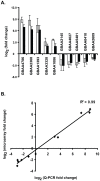Transcriptional profiling of Bacillus anthracis Sterne (34F2) during iron starvation
- PMID: 19768119
- PMCID: PMC2742718
- DOI: 10.1371/journal.pone.0006988
Transcriptional profiling of Bacillus anthracis Sterne (34F2) during iron starvation
Abstract
Lack of available iron is one of many environmental challenges that a bacterium encounters during infection and adaptation to iron starvation is important for the pathogen to efficiently replicate within the host. Here we define the transcriptional response of B. anthracis Sterne (34F(2)) to iron depleted conditions. Genome-wide transcript analysis showed that B. anthracis undergoes considerable changes in gene expression during growth in iron-depleted media, including the regulation of known and candidate virulence factors. Two genes encoding putative internalin proteins were chosen for further study. Deletion of either gene (GBAA0552 or GBAA1340) resulted in attenuation in a murine model of infection. This attenuation was amplified in a double mutant strain. These data define the transcriptional changes induced during growth in low iron conditions and illustrate the potential of this dataset in the identification of putative virulence determinants for future study.
Conflict of interest statement
Figures






References
-
- Ruthel G, Ribot WJ, Bavari S, Hoover TA. Time-lapse confocal imaging of development of Bacillus anthracis in macrophages. J Infect Dis. 2004;189:1313–1316. - PubMed
-
- Dixon TC, Fadl AA, Koehler TM, Swanson JA, Hanna PC. Early Bacillus anthracis-macrophage interactions: intracellular survival survival and escape. Cell Microbiol. 2000;2:453–463. - PubMed
-
- Dixon TC, Meselson M, Guillemin J, Hanna PC. Anthrax. N Engl J Med. 1999;341:815–826. - PubMed
Publication types
MeSH terms
Substances
Grants and funding
LinkOut - more resources
Full Text Sources
Medical
Molecular Biology Databases

